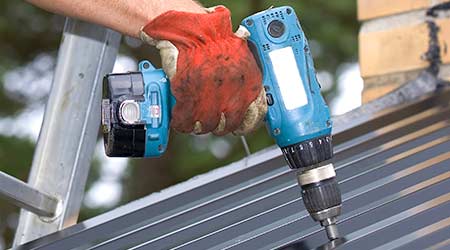 New-generation cordless power tools are more durable, lighter weight, more ergonomic and easier to control in order to improve the productivity of the front-line technicians who use them daily.
New-generation cordless power tools are more durable, lighter weight, more ergonomic and easier to control in order to improve the productivity of the front-line technicians who use them daily. Lithium-Ion Batteries Create Interruption-Free Work
Advances in power, versatility and battery technology can lead to more effective specification and application
A lithium-ion charger can recharge a battery in 30 minutes. An effective combination for interruption-free work is using at least two batteries — one in the tool on the job and one charging on the charger that will be ready in 30 minutes. Higher battery voltages of 18-36 volts (V) with an up to 8.0 ampere-hour power rating are more common.
While cordless tools have improved in terms of utility and uptime, another new feature is the battery-life-remaining indicator so technicians can swap out batteries before they run out of charge.
Battery chargers have several performance indicators to evaluate the battery in addition to simply charging it. One light indicates the charging cycle is on and working. A chip determines when the battery is no longer chargeable and turns on a blinking light. Another light indicates 80 percent charge, while another indicates full charge. The tool users can stop at 80 percent or continue to a 100 percent charge.
While no standard definition exists, a discharge/charge cycle is commonly understood as the full discharge of a charged battery with subsequent recharge, but this is not always the case. Batteries are seldom fully discharged, and manufacturers often use the 80 percent depth-of-discharge formula to rate a battery. Only 80 percent of the available energy is delivered; 20 percent remains in reserve. Cycling a battery at less than full discharge increases service life, and manufacturers argue that this is closer to the way batteries are used on the job. Batteries are commonly recharged with some spare capacity left.
Lithium-based batteries should always stay cool on charge. Technicians should discontinue the use of a battery or charger if the temperature rises more than 18 degrees above ambient under a normal charge. Lithium-based batteries cannot absorb overcharge and do not receive trickle charge when full. The tool user does not need to remove the battery from the charger, but if it goes used for a week or more, it is best to place the pack in a cool place and recharge it before use.
Inductive charging — contactless energy transfer — is going to alter the way technicians use and charge cordless power tools. With the charger plugged in and the battery sitting on the charger mat, an inductive charger transmits an alternating magnetic field. A copper coil in the battery acts as a receiver, a voltage is induced, and the current flows until the cells are fully charged.
With this system, every time the technician lays the tool on the mat during the job, the battery charges more, eliminating the need for a separate charging cycle. The battery is always on charge when not in use.
Pairing smart phones with Bluetooth-connected cordless power tool batteries allows users to track the batteries remotely and perform tool inventory management and control. They can turn all connected batteries on or off at once and get a warning and or disable it if a battery is out of range.
Other alerts the system can provide are a high-temperature warning and alert when a full charge has been achieved. The system provides inventory functions through the web or a cell phone app, such as keeping tool images and specifications and keeping history records and purchase receipts.
Selecting the most appropriate battery is not an issue if managers specify a combination kit, since the right batteries are generally included. Still, it is good practice to know the six characteristics to consider: battery type, voltage, capacity, self-discharge, memory effect, and life cycle.
Despite its higher initial cost, the most popular battery is lithium-ion. It has no self-discharge or memory effect, it is the lightest weight to power, it offers long run time, and it is safe and environmentally friendly.
Related Topics:










